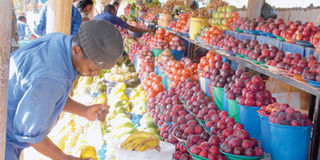I ate only unprocessed foods for a year

A fruit trader at Mombo township in Korogwe District, Tanga Region arranges his produce as he waits for customers. Health experts advise people to consume more fresh produce, however, consumers must take precautions so that they would not contract diseases. PHOTO | FILE
What you need to know:
“People don’t can food anymore because they’re worried they’re going to kill someone,” she says. We smile, relieved by this acknowledgment of botulism, and she promises to teach us how to do it safely.
We are a nervous dozen, hovering around an expanse of stainless-steel counter at Tucson’s Mercado San Agustín commercial kitchen. The session begins early; evidently those who sign up for a canning class at 9 a.m. on a warm Sunday are also a punctual bunch. Our instructor, Loraine, leads with this: “People don’t can food anymore because they’re worried they’re going to kill someone,” she says. We smile, relieved by this acknowledgment of botulism, and she promises to teach us how to do it safely.
I’m here because of tomatoes. Six months earlier, I committed to a year of unprocessed eating, one in which I’d explore how we process food — locally and industrially, individually and collectively. I’d prepared my own flour, sugar, wine, salt, milk and meat. And now, in the heat of Tucson’s tomato season, I wanted to learn how to preserve food for the coming winter without the help of cold storage.
I wanted to stop eating processed food for a lot of reasons. There was the environment: We live in an era of climate change, when natural resources are becoming scarce and our food system is increasingly dependent on fossil fuels.
There were political reasons, as I considered the enormous influence that food companies wield in our national politics. And there were economic reasons: I wanted to spend what little money I earned endorsing my local food system, one that I hoped was visible, accountable and scalable. I was also tired of reading about what I should do. I wanted to explore what I could do.
As it turned out, it would take me most of the year to figure out what makes food processed. With a few exceptions — say, a raw, foraged mushroom — all food has undergone some processing, by way of harvest, packaging or heat, before landing on our plates. Often, that’s a good thing.
But increasingly, it is not. If we understand the difference between an apple and a bag of Chex Mix, and if that difference matters for the health of our bodies and the environment, then the question of what makes a food too processed also matters.
I had to start somewhere, so I began with the belief that a food was unprocessed if I could theoretically make it in my home kitchen. I could — and did — grind wheat berries into flour, though I couldn’t take that flour and sift out its endosperm and bleach it into fluffy whiteness. I could gather honey and grind nuts into butter, but I wouldn’t refine sugar, stock up on chemicals or mix emulsifiers.
I ate fried local eggs, with their bright, gooey yolks, and slid them atop jumbles of fresh vegetables, provisioned almost entirely by my Tucson Community Supported Agriculture share.
I simmered beans in my crockpot and whole grains on my stove. I baked bread, cultured yogurt and made chocolate. Basically, I ate things that were obviously and intuitively food — that is, food without chemical additions or processed subtractions.
As my year progressed, so too did my definitions. At first, I focused on how processing changes food and how our bodies react to that change. Think, for example, of the difference between eating an orange and drinking orange juice.
Although they both contain the same kind of sugar, the whole fruit binds it with fiber and cellulose — like sticky duct tape that the body takes time and effort to unwind and rip open. A cup of orange juice from a carton, on the other hand, provides an immediate dose of sugar; too much sugar consumed too quickly overloads the liver.
As I learned about how specific foods are grown, harvested and transported, I started to wonder if the production of a food might make it processed, even if it’s a food we might otherwise think of as whole. Consider the watermelon.
In the winter, 60 percent of the produce on U.S. supermarket shelves comes from Mexico, and most of that produce gets funneled through Nogales, Ariz., the nation’s third-largest port of entry. Warehouses at the border hold hundreds of thousands of pounds of produce in a time-halting 43-degree chill.
I talked to one produce broker who moves 150,000 melons every day during the high season. The survival of the watermelon that winds its way through this system depends on pesticides, artificial refrigeration and semi trucks — not to mention cheap migrant labor on both sides of the border.
Compare that odyssey to the journey a watermelon takes from the Tucson CSA’s Crooked Sky Farms to my kitchen. That melon grows on a diversified field, adjacent to rows of squash and eggplant and tomatoes. It’s harvested by two women earning a living wage, and it spends a day in transit before it lands in my kitchen. It is grown organically, so it’s not covered in pesticide residue, as is 65 percent of conventionally grown produce, according to a study by the Environmental Working Group.
As with all foods, what makes one piece of produce more processed than another is how much is required to get it from field to table. On average, 91 cents of every dollar American consumers spend on food goes to middlemen: suppliers, marketers, retailers.
That means that the people who grow the food we eat — and even the corn in cheddar-flavor Chex Mix begins as a plant grown by someone — receive only nine cents of every dollar we spend.
According to a study by Civic Economics, if a community the size of Tucson (population: 526,000) shifted 10 percent of its spending to local businesses — a 10 percent shift, not an increase — within one year, we would create almost $140 million in new revenue for people in the city. What that also means, I realized, is that we would withhold millions from the balance sheets of large food and agribusiness corporations that are using our money to grow, process and sell foods that aren’t good for us or the environment. If we stop buying from companies that sell cheap, processed foods, those companies will stop selling processed foods. Indeed, many people have — major packaged-food companies lost $4 billion in market share in 2014 as shoppers sought less-processed alternatives.
For me, the hardest part was cost. Americans spend a relatively small fraction of their disposable income on food consumed at home — 5.6 percent in 2013, compared with the 10 to 15 percent common in other developed countries.
That’s because processed food, on a cost-per-calorie basis, is quite cheap. When I started my unprocessed year, I was a graduate student earning just under $17,000, and now I was proposing to spend more on food. I saved every receipt for every food item I purchased, and at the end of my year, I tallied it all up. The grand total? For a year’s worth of unprocessed food, I spent about $4,900 — roughly $4.50 per meal, or 27 percent of my income.
In the last week of my unprocessed year, I took the SNAP Challenge, a gauntlet thrown by community food banks across the country to eat on $30 for a week, the amount that 46 million people in the United States receive from the Supplemental Nutrition Assistance Program, or SNAP.
It shakes out to $1.40 a meal — not nearly enough to shop at the farmers market or the food cooperative where I bought most of my unprocessed wares. It’s enough to buy some fresh produce, potatoes, dried beans and rice at a big-box supermarket like Walmart, but just barely.
I am lucky that I can choose to spend $20 every week at my local farmers market, but ultimately, the best way to make fresh, local, organic foods more accessible is to rewrite the farm bill, the legislation that supported industrial growers of corn, cotton, wheat, rice and soybeans to the tune of 70 percent of total subsidies between 1995 and 2010.
The reason organic broccoli costs more than processed corn is because, for the most part, our government doesn’t subsidize organic broccoli growers. Still, that doesn’t mean consumers don’t have responsibility. The money we spend on food has the power to change the way the system works — or perpetuate the status quo.
For me, eating unprocessed food has become routine. Four years later, my diet is still about 90 percent unprocessed. I feel better, stronger and fuller. And I’ve found a sense of community in the place I live.
While it’s true that dollars spent on local businesses are dollars withheld from unaccountable corporations, it’s also true that spending money better can make for a more lovely Sunday morning — and a more delicious Sunday dinner.
Megan Kimble is the author of “Unprocessed: My City-Dwelling Year of Reclaiming Real Food”. She also writes for The Post.



